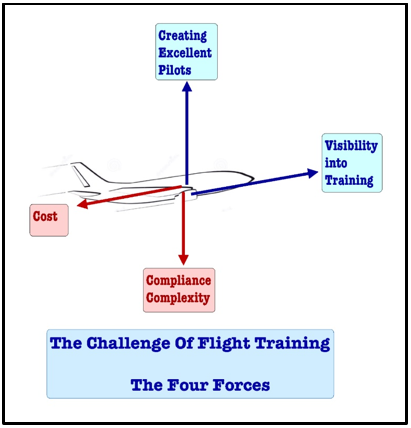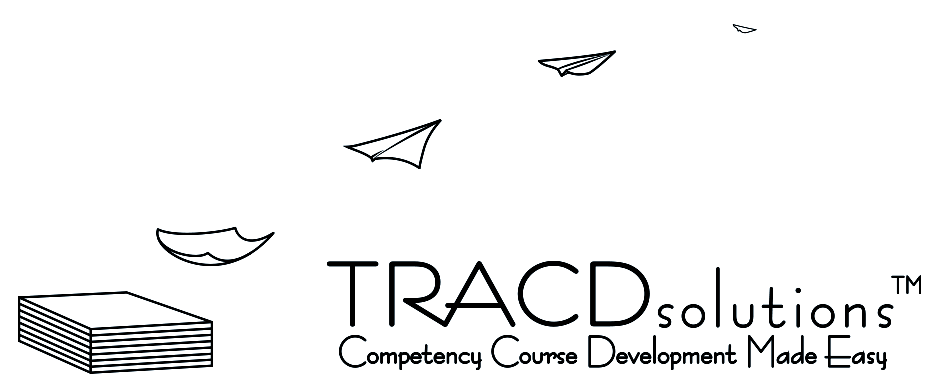The Four Forces of Training – Part 2 - Minimize Compliance Complexity
The great challenge of flight training is not to balance the four forces (there is no profit in that), but through management actions to set the two forces of “Visibility” and “Creating Excellent Pilots” to their maximum and to minimize the effects of “Cost” and “Compliance Complexity”. This will provide you with acceleration and growth in your training.
In this article I’ll focus on the important consideration of minimizing Compliance Complexity in the training process:
![]() Courses: Creating Part 61 courses is a complex, time consuming and technical process. Using course creation specialist can minimize the possibility of creating a course that is not compliant. I have just helped a client whose Instrument Rating course (approved by CASA!) did not have the required Part 61 Units in the syllabus! This considerable compliance risk can be minimized by using course creation experts.
Courses: Creating Part 61 courses is a complex, time consuming and technical process. Using course creation specialist can minimize the possibility of creating a course that is not compliant. I have just helped a client whose Instrument Rating course (approved by CASA!) did not have the required Part 61 Units in the syllabus! This considerable compliance risk can be minimized by using course creation experts.
![]() Updates: Courses are required by legislation to be “auditable” and must be updated to address “deficiencies” in training outcomes (141.260 (1) (mb) or 142.265 (1)(b)). Updating training courses which are in Word documents can be complex and time consuming and error prone. This risk can be minimized by using database software that takes all the formatting complexity and data duplication errors away to make it a quick and easy process.
Updates: Courses are required by legislation to be “auditable” and must be updated to address “deficiencies” in training outcomes (141.260 (1) (mb) or 142.265 (1)(b)). Updating training courses which are in Word documents can be complex and time consuming and error prone. This risk can be minimized by using database software that takes all the formatting complexity and data duplication errors away to make it a quick and easy process.
![]() Audits: CASA requires that courses must be upgraded “in the light of training deficiencies” (141.260 (1) (mb) or 142.265 (1)(b)). Paper based courses or some digital record systems do not provide the necessary data to identify deficiencies. Can your current system tell you that, for example, 30% of your students failed to achieve competency for a particular Performance Criteria at the scheduled point in the course? If it could, you could then: move the target, add more revision prior, update your training notes or teaching diagrams, or even re-sequence that item so that it is taught earlier in the lesson/course. How will you know which individual Performance Criteria are causing problems? Finding them in paper based/limited digital systems is a nightmare. This can be minimized through software that provides you with this statistical type of information automatically which you can then show to CASA to prove compliance and explain why you are upgrading your course.
Audits: CASA requires that courses must be upgraded “in the light of training deficiencies” (141.260 (1) (mb) or 142.265 (1)(b)). Paper based courses or some digital record systems do not provide the necessary data to identify deficiencies. Can your current system tell you that, for example, 30% of your students failed to achieve competency for a particular Performance Criteria at the scheduled point in the course? If it could, you could then: move the target, add more revision prior, update your training notes or teaching diagrams, or even re-sequence that item so that it is taught earlier in the lesson/course. How will you know which individual Performance Criteria are causing problems? Finding them in paper based/limited digital systems is a nightmare. This can be minimized through software that provides you with this statistical type of information automatically which you can then show to CASA to prove compliance and explain why you are upgrading your course.
![]() Upgrades: At some point CASA will modify, upgrade or simply change the contents of training units. For those companies using training courses and record sheets which are created in word processors, this will be a nightmare. This can be minimized by using database software that can simply “push” new criteria to your course and highlight them for change.
Upgrades: At some point CASA will modify, upgrade or simply change the contents of training units. For those companies using training courses and record sheets which are created in word processors, this will be a nightmare. This can be minimized by using database software that can simply “push” new criteria to your course and highlight them for change.
![]() Evidence: Obtaining and retaining training evidence is a significant compliance consideration. This also comes up as a cost factor. Providing an easy way for instructors to record evidence, significantly reduces the possibility of negative compliance findings against your training. This is difficult to facilitate in paper based or some digital record systems. This can be minimized by using a mobile app to record training details and capture evidence – use “voice typing” of comments, take a photo or even video to directly upload to the record or add a PDF directly to the records via an iPad or Android app or from a computer.
Evidence: Obtaining and retaining training evidence is a significant compliance consideration. This also comes up as a cost factor. Providing an easy way for instructors to record evidence, significantly reduces the possibility of negative compliance findings against your training. This is difficult to facilitate in paper based or some digital record systems. This can be minimized by using a mobile app to record training details and capture evidence – use “voice typing” of comments, take a photo or even video to directly upload to the record or add a PDF directly to the records via an iPad or Android app or from a computer.
![]() Tracking: Training is often interrupted and students don’t always come up to standard when assessed. If the record system is cumbersome (or doesn’t even track items at the Performance Criteria and Underpinning knowledge level), then instructors will tend to go “Tick – I’m sure the student knows this bit” or “Tick- they didn’t do too well today, but they’ll be fine on the test”. Without an easy, intuitive manner of putting items in a “Not done/Not assessed Bucket”, instructors may be inclined to take the easy way out and corrupt the compliance process in the training. This also results in poorly trained pilots. This can only be minimized by a robust record system that is easy for instructors to use, can be completed “in the field” and does not penalize instructors with extra work to transfer training to subsequent lessons.
Tracking: Training is often interrupted and students don’t always come up to standard when assessed. If the record system is cumbersome (or doesn’t even track items at the Performance Criteria and Underpinning knowledge level), then instructors will tend to go “Tick – I’m sure the student knows this bit” or “Tick- they didn’t do too well today, but they’ll be fine on the test”. Without an easy, intuitive manner of putting items in a “Not done/Not assessed Bucket”, instructors may be inclined to take the easy way out and corrupt the compliance process in the training. This also results in poorly trained pilots. This can only be minimized by a robust record system that is easy for instructors to use, can be completed “in the field” and does not penalize instructors with extra work to transfer training to subsequent lessons.
![]() Completion: Prior to handing a student and the training record over to an examiner, the HOO must ensure that every Performance Criteria and underpinning knowledge item (not just Element) has been “Taught” and “Assessed” (61.195). Tracking the date or lesson number of every one of these items is going to be a key aspect of CASA surveillance and compliance auditing. Reviewing this in a paper based or limited digital system is a nightmare – I tried reviewing this once, so I know! This can be minimized through software that tracks, and then displays, for easy confirmation, a table detailing every item and the dates where it was “Taught” and “Assessed” twice as CASA prefers – see 61.195 (2)(a) & (c).
Completion: Prior to handing a student and the training record over to an examiner, the HOO must ensure that every Performance Criteria and underpinning knowledge item (not just Element) has been “Taught” and “Assessed” (61.195). Tracking the date or lesson number of every one of these items is going to be a key aspect of CASA surveillance and compliance auditing. Reviewing this in a paper based or limited digital system is a nightmare – I tried reviewing this once, so I know! This can be minimized through software that tracks, and then displays, for easy confirmation, a table detailing every item and the dates where it was “Taught” and “Assessed” twice as CASA prefers – see 61.195 (2)(a) & (c).
What “Compliance Complexity” aspects cause you most difficulty in your training? What areas do you need to work on? If you would like to see how TRACDsolutions solves this problem of the 4 forces click here. We can provide you with a solution that will minimize your costs and compliance issues and maximize your profits and results, just head over here or give me a call. In the next articles I will cover the remaining 2 forces to show how you can improve the force for “Creating Excellent Pilots” and minimize the drag caused by “Costs”.
Hadyn Siggins.

